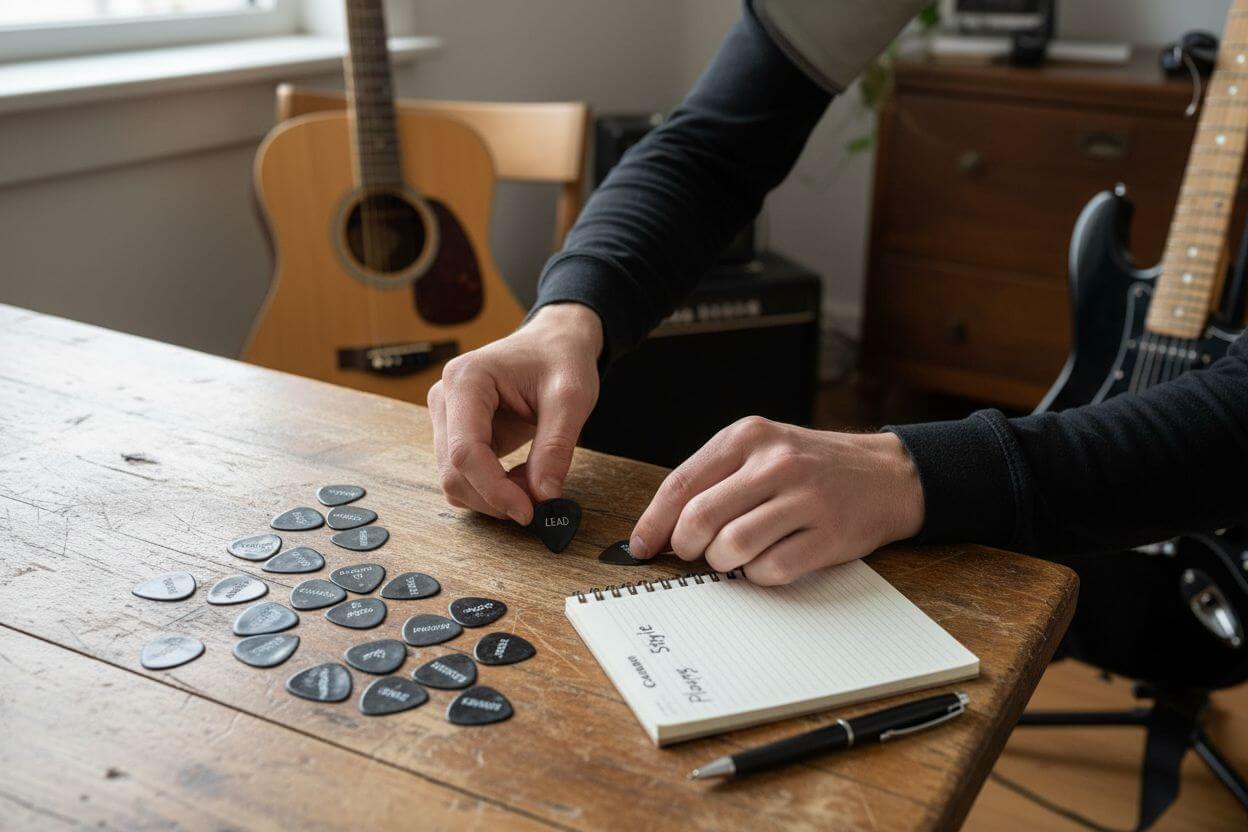Choosing a guitar pick seems like a small detail when you are chasing the perfect sound. Yet the tiniest slab of plastic or carbon can change everything. Some players find their ideal tone just by upgrading their picks and a shift in thickness as little as 0.2mm can totally transform your playing comfort and sound. Most never realise just how much their choice of pick holds them back until they try something different.
Table of Contents
- Step 1: Identify Your Playing Style And Technique
- Step 2: Evaluate Pick Materials And Their Impact
- Step 3: Assess Pick Shape And Size Options
- Step 4: Test Different Picks For Sound And Comfort
- Step 5: Finalise Your Selection And Organise Your Picks
Quick Summary
| Key Point | Explanation |
|---|---|
| 1. Assess Your Playing Style | Understand your unique guitar technique to select the right pick that complements your musical approach. |
| 2. Evaluate Pick Materials | Test different materials for their tonal quality and durability, as they significantly affect your overall sound experience. |
| 3. Experiment with Shape and Size | Different pick shapes and sizes impact comfort and technique; try various options to find your perfect match. |
| 4. Systematically Test Picks | Create a structured environment to compare picks, focusing on sound, comfort, and performance across genres. |
| 5. Organise Your Pick Collection | Maintain a diverse selection of picks and systematise them for easy access, ensuring optimal performance for any situation. |
Step 1: Identify Your Playing Style and Technique
Selecting the right guitar pick begins with a deep understanding of your unique playing style and technique. Every guitarist approaches their instrument differently, which means the perfect pick varies dramatically between musicians. Your individual technique profoundly influences pick selection, making this initial step crucial in finding your ideal guitar accessory.
Start by critically examining how you currently play guitar. Are you a strummer who loves big, bold chords in rock or folk music? Perhaps you’re a precision lead guitarist focusing on intricate soloing techniques? Or maybe you explore delicate fingerstyle arrangements that require nuanced control? Each playing approach demands different pick characteristics.
Playing Style Assessment Factors:
- Speed and attack of your picking technique
- Genre and musical style you predominantly perform
- Preferred tone and sound texture
- Technical complexity of your typical musical pieces
Consider your physical technique carefully. Guitarists with aggressive, hard-hitting styles typically benefit from thicker, more rigid picks that provide substantial resistance and control. Conversely, musicians performing intricate fingerstyle or jazz arrangements might prefer thinner, more flexible picks that offer greater sensitivity and responsiveness.
Your musical genre plays a significant role in pick selection. Heavy metal and hard rock players often gravitate towards thick, sharp-edged picks that facilitate rapid alternate picking and aggressive attack. Classical and acoustic players might prefer softer, rounded picks that produce warmer, more nuanced tones. Learn more about guitar playing styles and techniques to refine your understanding.
To verify you’ve successfully completed this step, reflect on your current playing technique. Can you articulate your primary musical style, picking approach, and desired sound? If you can describe these elements clearly, you’re ready to move forward in selecting your perfect guitar pick. Remember, understanding yourself as a musician is the foundational key to finding the right equipment.
Step 2: Evaluate Pick Materials and Their Impact
After understanding your playing style, the next critical step in selecting guitar picks involves a comprehensive evaluation of materials and their distinct sonic characteristics. Each pick material offers unique properties that dramatically influence tone, durability, and playing experience.
Traditional Materials Overview: Classic guitar pick materials range from celluloid and nylon to more advanced composites like carbon fibre and metal. Your material choice significantly impacts your instrument’s sound, feel, and overall performance. Understanding these nuanced differences will help you make an informed selection.
Celluloid picks represent the traditional standard, offering a warm, classic tone preferred by many vintage and acoustic players. They provide a soft attack and gentle resonance that complements folksy and traditional musical styles. However, they can wear down quickly and might not suit high-intensity playing techniques.
Nylon picks emerge as a versatile alternative, delivering remarkable flexibility and durability. Musicians who require consistent performance across multiple genres appreciate nylon’s balanced response. These picks maintain their shape longer and produce a brighter, more articulate sound compared to celluloid. They work exceptionally well for players transitioning between rhythm and lead techniques.
Advanced materials like carbon fibre and metal picks represent the cutting edge of guitar pick technology. Carbon fibre picks offer extraordinary precision and minimal flexibility, perfect for technical metal and progressive music styles. Metal picks create an aggressive, sharp tone with maximum attack, ideal for musicians seeking extreme sonic definition.
Material Selection Considerations:
- Tonal characteristics desired
- Playing intensity and technique
- Durability requirements
- Personal comfort and grip
To thoroughly evaluate pick materials, experiment with multiple options. Visit a music store and request sample picks across different materials. Explore comprehensive guitar playing techniques to understand how material selection interconnects with your musical approach.
Verify your material selection by testing picks in your typical playing environment. Listen critically to tone changes, assess comfort during extended playing sessions, and note how different materials interact with your specific guitar and playing style.
Below is a table comparing common guitar pick materials, summarising their tonal characteristics, durability, and suitability for different playing styles.
| Material | Tonal Qualities | Durability | Suitability for Playing Styles |
|---|---|---|---|
| Celluloid | Warm, classic tone | Wears down quickly | Vintage, acoustic, folk; gentle strumming |
| Nylon | Bright, articulate | Flexible, long-lasting | Versatile; rhythm and lead; multi-genre |
| Carbon fibre | Precise, controlled | Extremely durable | Technical metal, progressive; precise picking |
| Metal | Aggressive, sharp | Maximum durability | Extreme sonic definition; aggressive playing |
| The perfect pick material should feel like a natural extension of your musical expression, enhancing rather than hindering your performance. |
Step 3: Assess Pick Shape and Size Options
Pick shape and size represent crucial elements in your guitar playing experience, directly influencing your technique, comfort, and sonic output. Understanding the intricate relationship between pick geometry and performance will help you make a refined selection that complements your musical approach.
Traditional pick shapes generally fall into three primary categories: standard teardrop, Jazz III, and exotic designs. The classic teardrop shape remains the most versatile, offering broad appeal across multiple playing styles. These picks provide balanced control and consistent string interaction, making them an excellent starting point for musicians exploring different techniques.
Critical Shape Considerations:
- Tip sharpness and attack characteristics
- Grip comfort and ergonomic design
- String interaction and tonal variations
- Compatibility with your playing technique
Jazz III picks represent a more compact, precision-focused alternative. Their smaller size and pointed tip enable faster, more articulate playing, particularly beneficial for lead guitarists and technical musicians. These picks facilitate rapid alternate picking and intricate note articulation, making them popular among progressive and metal players seeking maximum note definition.
Beyond traditional shapes, exotic pick designs emerge as innovative solutions for specialized playing techniques. Picks with extended wings, asymmetrical edges, or unique contours can provide enhanced grip and control. Some guitarists discover that unconventional shapes dramatically improve their playing comfort and technical execution.
Pick thickness plays an equally significant role in your selection process. Thinner picks between 0.40mm and 0.60mm deliver greater flexibility and softer attack, ideal for strumming acoustic rhythms. Medium picks ranging from 0.60mm to 0.80mm offer balanced performance across multiple genres.
This table provides an overview of typical pick thickness categories, summarising their technical characteristics and the musical contexts to which they are best suited.
| Thickness Range | Flexibility | Typical Use | Ideal Genres/Techniques |
|---|---|---|---|
| 0.40mm – 0.60mm | High | Softer attack, easy strumming | Acoustic, folk, beginner strumming |
| 0.60mm – 0.80mm | Medium | Balanced performance for several techniques | Pop, soft rock, rhythm and moderate lead |
| 0.80mm and above | Low (rigid) | Maximum control, precise tone | Rock, metal, technical lead, fast picking |
| Thick picks exceeding 0.80mm provide maximum rigidity, supporting aggressive playing styles in rock and metal. |
Learn more about advanced guitar playing techniques to understand how pick shape influences musical expression. Experiment with various shapes by purchasing sampler packs that allow comprehensive exploration without significant investment.
To verify successful pick shape assessment, perform a comprehensive evaluation. Test multiple shapes during extended playing sessions, noting comfort, tonal variations, and technical performance. The ideal pick should feel like a natural extension of your hand, enabling smooth, effortless musical expression across your preferred playing techniques.
Step 4: Test Different Picks for Sound and Comfort
Testing different guitar picks represents the most critical stage in your selection process, transforming theoretical knowledge into practical musical experience. This step requires systematic exploration, patience, and a critical ear to discover the pick that perfectly resonates with your playing style and sonic preferences.
Begin by creating a structured testing environment that allows comprehensive evaluation. Select a consistent guitar and amplification setup to ensure that variations in tone and feel stem directly from pick differences. Prepare to record short audio samples during your testing, enabling precise comparison and reflection.
Systematic Testing Approach:
- Record multiple short performance segments
- Test picks across different musical genres
- Evaluate comfort during extended playing
- Compare tonal characteristics objectively
Start with fundamental techniques like single-note picking, chord strumming, and rhythmic patterns. Pay close attention to how each pick influences string attack, sustain, and harmonic complexity. Some picks will produce brighter, more percussive tones, while others generate warmer, more rounded sounds.
Consider the physical comfort of each pick as equally important as tonal qualities. A technically superior pick becomes irrelevant if it causes hand fatigue or uncomfortable grip. Examine how each pick feels during different playing techniques, noting pressure points, slip resistance, and overall ergonomic performance.
Dynamic testing involves exploring various musical contexts. Transition between clean acoustic passages, overdriven rock sections, and delicate fingerstyle arrangements. Each genre and technique will reveal different pick characteristics, helping you understand nuanced performance variations.
Grip texture plays a significant role in pick selection. Manufacturers now offer picks with specialized surface treatments like micro-grip patterns or textured edges. These innovations can dramatically improve pick control, reducing slippage during intense playing moments.
Explore advanced guitar playing techniques to understand how subtle pick variations impact musical expression. Experiment with picks from different manufacturers, understanding that each brand offers unique design philosophies.
Verify your testing by creating a comprehensive comparison sheet. Document tone quality, comfort level, technical performance, and personal preference for each pick. The ideal pick will consistently emerge as the most comfortable and sonically satisfying across multiple playing scenarios.
 Trust your ears, trust your hands, and remember that the perfect pick feels like a natural extension of your musical expression.
Trust your ears, trust your hands, and remember that the perfect pick feels like a natural extension of your musical expression.
Step 5: Finalise Your Selection and Organise Your Picks
Finalising your guitar pick selection represents more than simply choosing a single option. This crucial step involves creating a strategic pick collection that supports your evolving musical journey, ensuring you are prepared for diverse playing scenarios and continued technical growth.
Reflect carefully on the comprehensive testing you have completed. Your ideal pick should demonstrate consistent performance across multiple playing techniques, offering both comfort and sonic versatility. Select primary picks that align most closely with your predominant playing style, while maintaining a diverse selection to accommodate different musical contexts.
Strategic Pick Collection Considerations:
- Primary performance picks
- Backup and alternative options
- Picks for specific musical genres
- Emergency replacement picks
Organise your picks systematically to maintain accessibility and prevent loss. Invest in a dedicated pick holder or wallet that allows categorisation by material, thickness, and shape. Professional musicians often colour-code or label their picks, enabling quick identification during performance or practice sessions.
Consider purchasing picks in multiple quantities of your preferred type. While experimentation is valuable, having a reliable stock of your optimal pick ensures uninterrupted musical practice. Some musicians maintain separate pick collections for studio recordings, live performances, and practice sessions, recognising that different environments demand nuanced equipment approaches.
Develop a maintenance routine for your pick collection. Regularly inspect picks for wear, examining edges for smoothness and checking for potential structural compromises. Picks are relatively inexpensive accessories, so do not hesitate to replace them proactively to maintain optimal playing performance.
Explore advanced guitar playing techniques to understand how professional musicians manage their equipment. Create a small emergency pick kit that you can carry to gigs, rehearsals, and recording sessions, ensuring you are always prepared for unexpected scenarios.
Verify your selection by assessing your pick collection against three critical criteria. First, ensure your picks support your primary playing style comprehensively. Second, confirm you have diverse options for different musical contexts. Third, validate that your collection feels comfortable and intuitive. Your perfect pick collection should feel like a natural extension of your musical toolkit, empowering your artistic expression with confidence and flexibility.
![]()
Ready to Find Your Ideal Guitar Pick?
Struggling to pinpoint the perfect guitar pick for your unique playing style? After reading our guide, you know how factors like pick shape, material, and comfort can transform your sound and confidence. Many players feel overwhelmed by the choices and worry they might never find a pick that truly matches their technique. At MusicStreet, we understand the frustration of endless trial and error, and we want to make the journey simple for you.

Discover the right pick and accessories by browsing our trusted online guitar shop. We are leading suppliers of top brands and high quality gear, including guitar picks that meet every style and preference. Visit MusicStreet now to explore our range, ask for expert advice, and experience why musicians across the UK choose us for their essential accessories. Do not wait – elevate your playing today with a pick that feels custom-made for you.
Frequently Asked Questions
How do I identify my guitar playing style for selecting the right pick?
Understanding your playing style is essential in choosing the right guitar pick. Reflect on how you typically play—are you a strummer, a lead guitarist, or do you focus on fingerstyle? Once you can articulate your primary techniques and desired sound, you can proceed to select a pick that complements your style.
What factors should I consider when evaluating guitar pick materials?
When choosing pick materials, consider their tonal characteristics, durability, and how they feel in your hand. Different materials, such as celluloid, nylon, or carbon fibre, will affect your sound and comfort. Experiment with various materials to find which aligns with your playing technique and genre preferences.
How do pick shape and size affect my guitar playing experience?
Pick shape and size influence your comfort and control while playing. Explore various pick shapes, such as standard teardrop or Jazz III, along with different thicknesses to see how they impact your technique and sound. Testing different shapes is crucial; find what feels best in your hand and enhances your performance.
What is the best way to test guitar picks for sound and comfort?
To effectively test guitar picks, create a consistent environment with your preferred guitar setup and record your performance with each pick. Try out different playing techniques, genres, and look for tonal variations and physical comfort during extended use. Document your findings to compare picks and make an informed choice.
How should I organise my guitar pick collection once I’ve selected my favourites?
Organise your guitar picks systematically to ensure easy access and prevent loss. Use a dedicated pick holder or wallet to categorize picks by material, thickness, or shape, making it easy to grab the right one for each playing situation. Regularly inspect your picks for wear to maintain optimal performance.




Share:
Comprehensive Guide to Guitars
What is Boutique Guitar? Understanding Unique Instruments